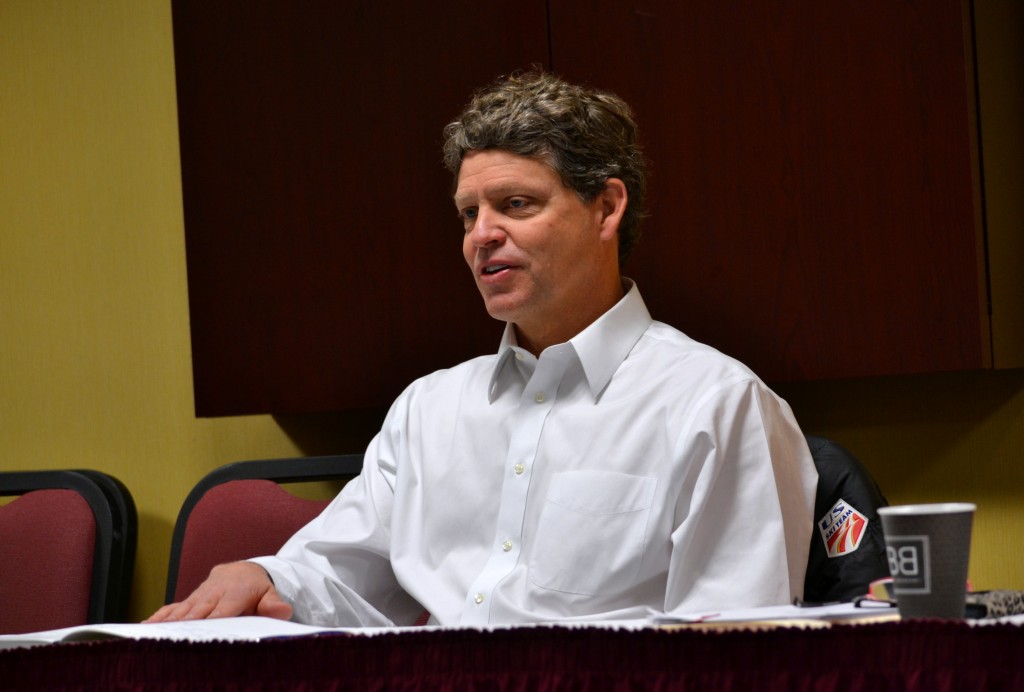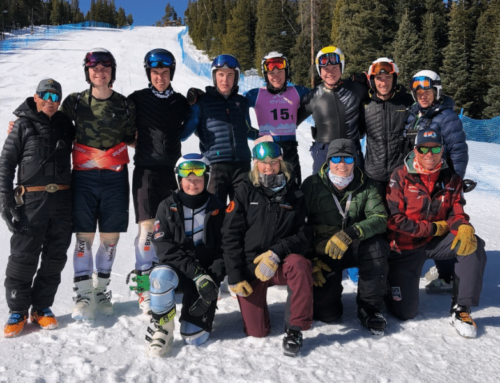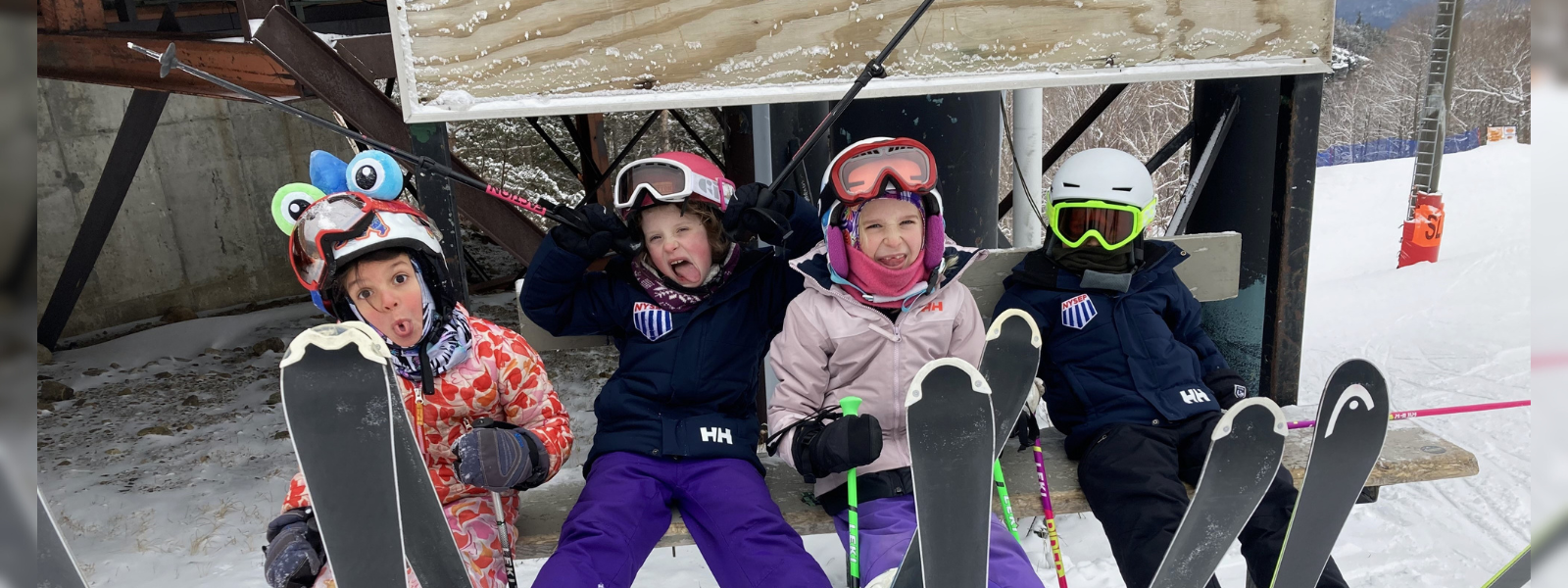Shaw redefines ‘Best in the World’ to include sub-elite track
WHITE RIVER JUNCTION, Vt. — Almost as if directly responding to Bill Gunesch’s opinion article on declining participation rates in youth ski racing, newly appointed USSA President and CEO Tiger Shaw kicked off his address to attendees of the Eastern Alpine Competition Committee spring meeting on Sunday (April 27) with a bold plan to broaden the spectrum of his organization’s vision to be ‘Best in the World’.
“There are major challenges that lie ahead for myself and for our organization. Number one is staying on the top where we already are on the top. And as all of you know, once you get there everybody is shooting at you. So it’s rather entertaining to have the Swiss and the Austrians trying to figure out what we’re doing and a little less of us trying to figure out what the Austrians and the Swiss are doing. … But we look at our pipeline, tech for instance, men and women, and we know we’re not where we want to be. So what are we going to do about it?” Shaw proposed to his audience of coaches, program directors, and industry members.
On the elite level, the U.S. Ski Team has a nearly invaluable resource in the Copper Mountain Speed Center, likely the only venue worldwide which offers full length downhill training in the lead up to November and December World Cup races. It’s a version of currency for the national team whose coaches offer access in exchange for favors and trades in Europe, as was done with the Russian team before Sochi and will likely occur with the Korean team heading into Pyeonchang. Strategic international alliances have helped raise some athletes to peak performance on the global stage. But counting Olympic and world championship medals every four and two years is not a deep enough metric to evaluate the entire pipeline.
“Admittedly, according to McKinsey, the U.S. Ski and Snowboard teams have not done as great a job as we could have been doing integrating with our partners, being very much embedded with you and working closely with you,” Shaw told the coaches and club leaders in the room. “You feed the athlete to us that we try to take to the next level. … That’s something that I’m very open to adjusting and tweaking to make it work as best as possible.”
What Shaw believes is USSA’s greatest asset is its ability as the national governing body to bring the best athletes in the country together on both the lower and elite levels for training and competition opportunities. Logistically how that can best function is the question that remains to be refined, and Shaw referred to it as an open book that will require continual analysis and improvement in careful conjunction with clubs and programs throughout the country. As was noted in Gunesch’s article, Shaw specifically addressed the policy of bringing selected second-year U14 athletes to a U16 national project this year, but then remarked that a dialogue is necessary to make the best future decisions on these matters, asking the questions: “Does that make sense? To what extent does it make sense?”
Citing the existing $2.5 million budgetary deficit at USSA*, Shaw indicated that his entry into the position has come with difficult decisions early on. Membership attrition is something close to his heart, having coached for 12 years at the Ford Sayre Junior Racing program, a local club based in Hanover, N.H., and he has targeted a population to better serve in order to keep more individuals involved in the sport over a longer period of time.
“Being the best in the world athletically means caring an awful lot about our pipeline. Within your clubs and academies and programs, you all have anywhere from a few percent up to even over half of your athletes in that elite pipeline. There is a chance that one of them or some of them are going to make it all the way to the national team level and win medals someday. … Then, alongside them are the kids that want to just as badly make it there, but clearly they don’t have the skills, started a little too late, aren’t fast enough, and they’re not going to go there. They’re not going to make the national team, but they love trying. They love competing. They want to keep going … they love USSA racing. And this is what we call the alternate peak, or the alternate funnel or pipeline,” identified Shaw.
“Those are the kids that are sub-elite, but they want to be elite and they love competing and racing,” he continued. “We all know who they are because we have hundreds of them in our programs everywhere. Those are the kids who we need to find a better pathway for them. Some of that is high school, some of that is USCSA college racing, more USSA opportunities. But that is an area where I think USSA has sort of capped and forgotten about, and it also rolls into a lifetime of master’s racing, beer leagues, any type of competition on skis.”
It’s not simply about numbers, but rather, an entire system where the elite participants depend upon the sub-elite for the existence of junior ski racing programs in the first place.
“That’s an area that’s not in the elite part of what we do at USSA, but it’s very important that we expand that and grow that because the kids that are in that elite pipeline are the friends and teammates of the kids that aren’t. Admittedly, that group that isn’t in the elite pipeline is bigger than the group that is,” said Shaw. “In some clubs, it’s dramatically so. They’re the ones that are enthusiastic, that love it, that grow the numbers, that pay for the coaches and cover the club budget. They are the ones that make the whole system work. … Those kids and their parents are lifetime fans of the sport. They’re the ones that care deeply and get up and watch live timing on FIS to see what’s going on in Europe. It’s absolutely critical that they are supported as well.”
Although still in the developmental phase of implementation, some programs Shaw has in mind to address this vast percentage of the USSA membership includes club certification (launched last season), further development of coaches’ education, assisting clubs with fundraising efforts and bylaws and template creation, and establishing entry level grassroots opportunities to bring more athletes into the sport, keep it fun, and stem future attrition.
But if Shaw’s vision is to come to fruition, it will require buy-in from clubs all around the country, including the historically contentious Eastern Region which just two years earlier considered secession from the national governing body under the leadership of Shaw’s predecessor, Bill Marolt. While Shaw praised Marolt for his vision to help the U.S. Ski Team rise from near ashes to fulfill its goal of delivering medals and podium results, he assured Eastern Region leaders that there is a new sheriff in town.
“I want my staff to believe in (partnership), and I want my staff’s feet to be held to the fire with that. I want to hear it if it’s not happening,” Shaw said. “All you guys know where to find me.”
*See Tiger Shaw’s clarification regarding this statement in the comments below.






















